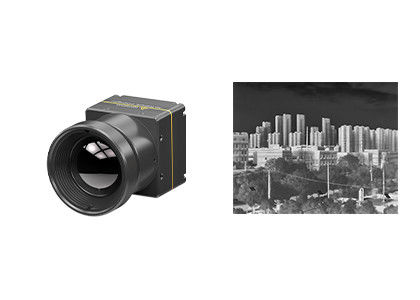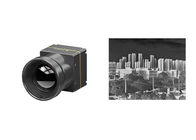-
Thermal Camera Core
-
Thermal Security Camera
-
Drone Thermal Camera
-
EO IR Systems
-
Thermal Imaging Binoculars
-
Infrared Thermal Camera Module
-
High Resolution Thermal Camera Module
-
Cooled Infrared Detectors
-
Optical Gas Imaging
-
Thermal Camera For Fever Detection
-
Cooled Camera Modules
-
Vehicle Mounted Thermal Camera
-
Integrated Dewar Cooler Assembly
-
Uncooled Infrared Detectors
Light & Flexible Uncooled Thermal Module with LWIR 640x512 / 12μm Infrared Detector Sensor

Contact me for free samples and coupons.
Whatsapp:0086 18588475571
Wechat: 0086 18588475571
Skype: sales10@aixton.com
If you have any concern, we provide 24-hour online help.
x| Resolution | 640x512 / 12μm | Size (mm) | 25.4x25.4x14.1 (With Shutter) |
|---|---|---|---|
| Typical Power Consumption | <0.75W | NETD | <40mK |
| Spectral Range | 8~14μm | Frame Rate | 25Hz/30Hz/50Hz/60Hz |
| Highlight | Uncooled Thermal Module,12μm Thermal Module,LWIR Thermal Module |
||
Light & Flexible Uncooled Thermal Module with LWIR 640x512 / 12μm Infrared Detector Sensor
COIN612/R infrared thermal camera module adopts state-of-the-art 12μm VOx microbolometer technology. It integrates 640x512 / 12μm wafer level package (WLP) infrared thermal detector, high performance signal processing circuit and image processing algorithm.
The COIN612/R infrared camera core presents sharp and detailed thermal images and has an optional thermographic function with measurement range from -20℃~550℃.
COIN612/R infrared camera module provides a standard set of interfaces for customers, which can be easily integrated into many kinds of devices like unmanned aerial vehicles (UAV), drones, as well as police and firefighting units. It is beneficial to OEM customers for secondary development and integration in all kinds of thermal imagers and infrared thermographic cameras.
- Compact size, light weight
- Precise temperature measurement
- Suitable for various infrared products
- A wide range of thermal imaging applications
- Low Power Consumption
| Model | COIN612/R |
| IR Detector Performance | |
| Resolution | 640x512 |
| Pixel Pitch | 12μm |
| Spectral Range | 8~14μm |
| NETD | <40mk |
| Image Processing | |
| Frame Rate | 25Hz/30Hz/50Hz/60Hz |
| Start-up Time | <3s |
| Analog Video | PAL/NTSC |
| Digital Video | RAW/YUV/BT656 |
| Dimming Mode | Linear/Histogram/Mixed |
| Digital Zoom | 1~8X Continual Zoom, Step Size 1/8 |
| Image Display | Black Hot/White Hot/Pseudo Color |
| Image Direction | Horizontally |
| Image Algorithm | NUC/AGC/IDE/DNR |
| Electrical Specification | |
| Standard External Interface | 30pin_HRS |
| Communication Mode | RS232-TTL, 115200bps |
| Supply Voltage | 3.5~5.5V |
| Typical Power Consumption | <0.75W |
| Temperature Measurement | |
| Operating Temperature Range | -10°C~50°C |
| Temperature Measurement Range | -20°C~150°C, 100°C~550°C |
| Temperature Accuracy | ±3°C or ±3% (Take the Maximum Value) |
| SDK | Support ARM/Windows/Linux SDK, Full Screen Thermography |
| Physical Characteristics | |
| Dimension (mm) | 25.4x25.4x14.1 (With Shutter) |
| Weight | Module: 13g±0.5g (With Shutter) Module+8.8mm Lens: 22.4g±0.5g Module+13mm Lens: 41g±0.5g Module+19mm Lens: 43.9g±0.5g |
| Environmental Adaptation | |
| Operation Temperature | -40°C ~ +70°C |
| Storage Temperature | -45°C ~ +85°C |
| Humidity | 5%~95%, Non-condensing |
| Vibration | Random Vibration 5.35grms, 3 Axis |
| Shock | Half-sine Wave, 40g/11ms, 3 Axis 6 Direction |
| Optics | |
| Optional Lens | Fixed Focus Athermal: 8.8mm/13mm/19mm |
The COIN612/R infrared camera module is widely used in Thermography, Security & Monitoring, Outdoors, Firefighting & Rescue, AIoT, Intelligent Hardware, UAV Payloads, ADAS etc.
![]()
![]()
1. What is the difference between low light, active IR and thermal imaging?
Low light needs natural light and transforms weak natural light image into enhanced electronic image through image intensifier;
Active IR actively emits infrared light and uses infrared beam reflected by the target. It has very poor concealment;
Thermal imaging doesn’t need any light and is a passive infrared night vision that detects infrared radiation difference between targets and scene or different parts of an object. not be affected by the changes of the surrounding lighting conditions, during night or even in fog, rain and other harsh environments.
2. Can you block thermal imaging?
In most cases, you cannot. But infrared rays can't penetrate walls, and also the glass can block IR. So, if you don’t want to be detected, you can conceal behind glass or walls to block the thermal imaging.




